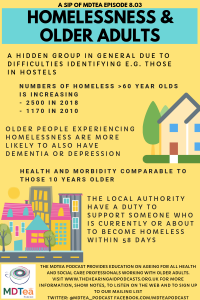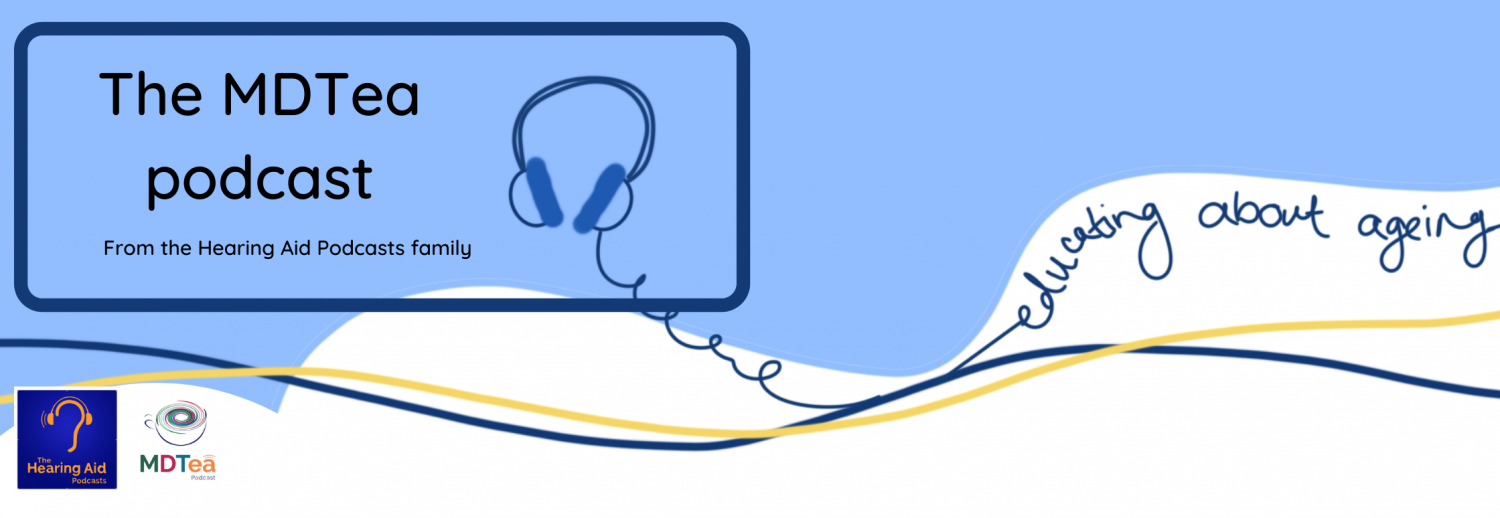8.03 Homeless Older Adults
Presented by: Dr Jo Preston, Jackie Lelkes
Faculty: Tracy Szekely
Broadcast Date: 10th September 2019

Social Media
Jackie: WiFi in Care Homes

Learning Objectives
Knowledge
- Understand the reasons an older adult might be homeless.
- Recall the legal framework for helping homeless older adults.
- Appreciate the adverse impact on health.
Skills
- To recognise those at risk of homelessness and signpost to support services.
Attitudes
- To appreciate the complexities associated with homeless older adults.
CPD Log
Show notes
Definitions
Formal definition
By law, you are homeless if you have no available accommodation or if you have accommodation but it is not reasonable for you to live there anymore.
Practical definition
The Shelter website outlines several situations in which a person can be legally defined as homeless:
- no accommodation available in the UK or abroad
- no legal right to occupy the accommodation
- split households and availability of accommodation for whole household
- unreasonable to continue to occupy accommodation
- violence from any person
- applicant unable to secure entry
- applicant lives in a moveable structure but has no place to put this
Shelter: Defining Homelessness (England)
Main Discussion
The local authority will have some duty towards them and this may range from advice to interim accommodation. The Housing (Homeless Persons) Act (1977) still underpins the responsibility of local authorities to assess people presenting as homeless against five main criteria:
- Are they homeless, or likely to be made homeless in the next 56 days?
- Are they eligible for assistance in England?
- Are they in ‘priority need’?
- Do they have a local connection? If not, which local authority should they be referred to?
- Are they intentionally homeless? In this situation support does not need to be provided. The local authority can say you made yourself ‘intentionally homeless’ if you are homeless because of something you deliberately did or failed to do (a ‘deliberate act or omission’).
However, an act or omission is generally not considered deliberate if:
- it was the result of limited mental capacity or a temporary lapse in capacity caused by mental illness, frailty or an assessed substance abuse problem.
- the local authority has reason to believe the person is incapable of managing their affairs, for example because of their age/capacity.
- the person acted with imprudence or lack of foresight, but in good faith.
In these circumstances the local authority must do the following:
- carry out an assessment of the person’s circumstances and needs.
- draw up a plan of action for resolving (‘relieving’) or preventing homelessness. The plan of action is likely to set out certain steps a person is required to take. If they fail to take a required step, the local authority can say they have ‘deliberately and unreasonably refused to cooperate’.
- take ‘reasonable steps’ to help for around 56 days (help may be for a longer or shorter period).
The duty will not apply if the person has
- previously declined suitable accommodation.
- deliberately not cooperated.
Shelter: Defining Homelessness (England)
Homelessness is a hidden issue and the true number of people who are homeless in the UK can be difficult to establish. There are three main ways to assess the numbers of homeless people:
- statutory homeless households e.g. those receiving LA support
- rough sleepers
- those in hostels (most difficult group to identify)
How many homeless older adults are there?
- In 2015/16 Combined Homelessness and Information Network (CHAIN) surveyed rough sleepers in London and found 11% were over 55 (double that of previous surveys)
- 4% of statutory homeless households are over 60
- Shelter 2018: Number over 60 was 2,500 – compared to 1,170 in 2009/10
Centre for Policy on Ageing. 2017. Diversity in older age – Older Homelessness
Patterns of homelessness vary widely between countries and over time. According to Crane and Warnes (2006), in the United Kingdom, in the earlier half of the 20th Century, older people (aged over 50) predominated in the homeless population.
Impacts on health and wellbeing
- Health and mortality are comparable with someone 10 years older who is not homeless.
- Co-morbidity amongst the longer-term homeless population is not unusual; the average age of death of a homeless person is 47 (lower for women – 43), compared to 77 years amongst the general population.
- People who experience homelessness can struggle to access quality health and social care.
- This population includes those who have been homeless for years as well as those who become homeless for the first time in later life and, as with other populations, official statistics represent the ‘tip of the iceberg’.
The relationship between homelessness, health and wellbeing in later life is not documented to the same extent as for younger populations. A three-nation study identified that physical and mental health problems, alcohol abuse and gambling problems were contributory factors in homelessness experienced for the first time by people in later life, following on from death of a close relative, relationship breakdown, accommodation being sold or needing repair, and rent arrears.
Higher levels of poor mental health are recorded in the older homeless population. A study in the USA put this at 78% of the population.
Studies also indicate that existing health conditions are exacerbated by homelessness, and that older people experiencing homelessness are more likely to suffer from depression or dementia.
A study by Rogoz & Burke demonstrating that a large majority of older people experiencing homelessness, in inner cities of high‐income countries, showed impairment on tests of frontal lobe function, a finding that could have significant implications for any medical or psychosocial intervention.
How homeless adults access healthcare
- Most find GPs through word of mouth or the internet.
- They are most likely to register in person or by phone: this early interaction is really important and can be the difference between someone continuing to access care or not.
- Common myths about registering with a GP include
- ID is required
- Proof of address is required
- Immigration status should be confirmed
- NHS England states that “Anybody in England may register and consult with a GP without charge”.
There are ways that primary care can help, for example: if a patient can’t or won’t give proof of their address, by registering them under another address that can handle their medical correspondence, perhaps the surgery or another organisation such as a church or community centre the patient knows.
Other problems faced by this group:
- gaining access to health care and social services and to benefits for which they may be eligible;
- this group have particular needs in respect of safety and security, both on the streets and in hostels where they may be subject to bullying by younger homeless people;
- older people living on the street or in homeless shelters are unable to modify their “home environment” to prevent falls;
- extremely limited access to toileting facilities complicates efforts to manage incontinence; and
- corrective lenses and hearing aids for sensory impairments may not be affordable, and are easily lost or damaged.
Crane et al (2010) paper reviews the limited evidence on the causes of homelessness in old age and on the circumstances and problems of older homeless people, and it describes the few services dedicated to the group. Health and social care professionals rarely encounter homelessness among the many problems of older people that present to them, but in many developed countries there is evidence that the number of older homeless people has recently been growing. Some among them have been homeless intermittently or continuously for years, but many became homeless for the first time in later life. The reasons for becoming homeless and the problems and needs of the group are exceptionally diverse. Many have been estranged from their family or have no living relatives. Although services for homeless people in general have improved since the early 1990s, few have targeted the needs of older people.
The concept of ‘home’ for older people can be more significant: they can spend longer in it, can be nearer to family, friends and their support network, and it can hold more memories for them (both positive and negative). Petersen and Parsell (2015) found that 70% of older homeless individuals had a conventional housing history.
Greneir et al (2016) research focused on experiences at the intersections of ageing and homelessness, including social relationships, the challenges of living on the streets and in shelters in later life, and the future. This article outlines the 5 main themes that capture the experience of homelessness:
- age exacerbates worries
- exclusion and isolation
- managing significant challenges
- shifting needs and realities
- resilience, hope and strengths
Research by Alden (2017) found that some practitioners adopted an age-blind approach when assessing older groups, despite this being contrary to policy guidance on assessing vulnerability in England. Further, services and housing options aimed at older groups were viewed as inadequate due to a mixture of lack of awareness, targeting and resources. It is concluded that assessment of vulnerability based on older age is complex, as whilst gerontological discourse may discourage viewing age as a number, homelessness scholars stress that rooflessness causes poor health conditions consistent with premature ageing. It is therefore asserted that policy makers must focus greater attention to developing suitable provision for older service users and look to incorporate a richer conceptualisation of how older age may impact upon the homelessness experience.
Research in America found that approximately:
- 40% of homeless older adults reported difficulty with one or more activities of daily living.
- one third reported having fallen in the past six months.
- one quarter had cognitive impairment.
- 45% had visual impairment.
- 48% percent had urinary incontinence.
Prevention measures include:
- monitoring rent arrears for signs of risk or vulnerability;
- help with social security benefit;
- help with financial problems;
- assessing for vulnerability in primary healthcare settings; and
- collaborative working between professional agencies.
Homelessness Reduction Act (2018):
Biggest change to the rights of homeless people. It effectively bolts two new duties to the original statutory rehousing duty:
- Duty to prevent homelessness
- Duty to relieve homelessness
The Act requires local authorities to provide free services to give people in their area information and advice on:
- preventing homelessness;
- securing accommodation if homeless;
- the rights of people who are homeless or threatened with homelessness; and
- any help that is available for people who are homeless or likely to become homeless, as well as how to access that help.
Legal support available
- Shelter has a free advice helpline, open 365 days a year.
- Legal aid is available in areas such as defending evictions, challenging local authority decisions on homelessness and establishing rights to the family home if a person has experienced domestic violence.
Curriculum Mapping
NHS Knowledge Skills Framework
- Core 1 Level 3
- Core 2 Level 1
- Core 3 Level 2
- Core 6 Level 1
- HWB1 Level 1
- HWB2 Level 2
- HWB3 Level 1
- HWB4 Level 3
Foundation Programme
- 2. Delivers patient centred care and maintains trust
- 3. Behaves in accordance with ethical and legal requirements: Protection of vulnerable groups
- 4. Keeps practice up to date through learning and teaching
- 10. Recognises, assesses and manages patients with long term conditions
- 16. Demonstrates understanding of the principles of health promotion and illness prevention
Core Medical Training
- The patient as central focus of care
- Managing long-term conditions and promoting patient self-care
- Health promotion and public health
- Principles of medical ethics and confidentiality
- Alcohol and substance dependence
- Geriatric medicine
GPVTS
- 3.01 Healthy People: promoting health and preventing disease
- 3.05 Care of Older Adults
- 3.10 Care of People with Mental Health Problems
- 3.14 Care of People who Misuse Drugs and Alcohol
Geriatric Medicine Specialty Training
- 6. The patient as central focus of care
- 11. Managing long-term conditions and promoting patient self-care
- 16. Health promotion and public health
- 19. Legal framework for practice
- 29. Diagnosis and management of chronic disease and disability
- 31. Planning transfers of care, including discharge
- 42. Psychiatry of old age
- 44. Care of older people living with frailty




